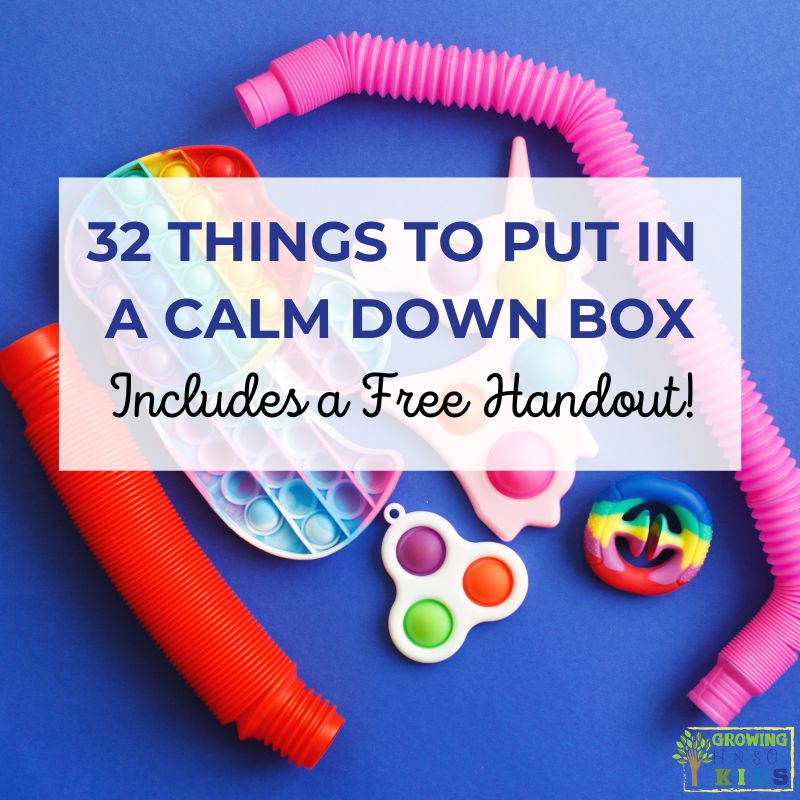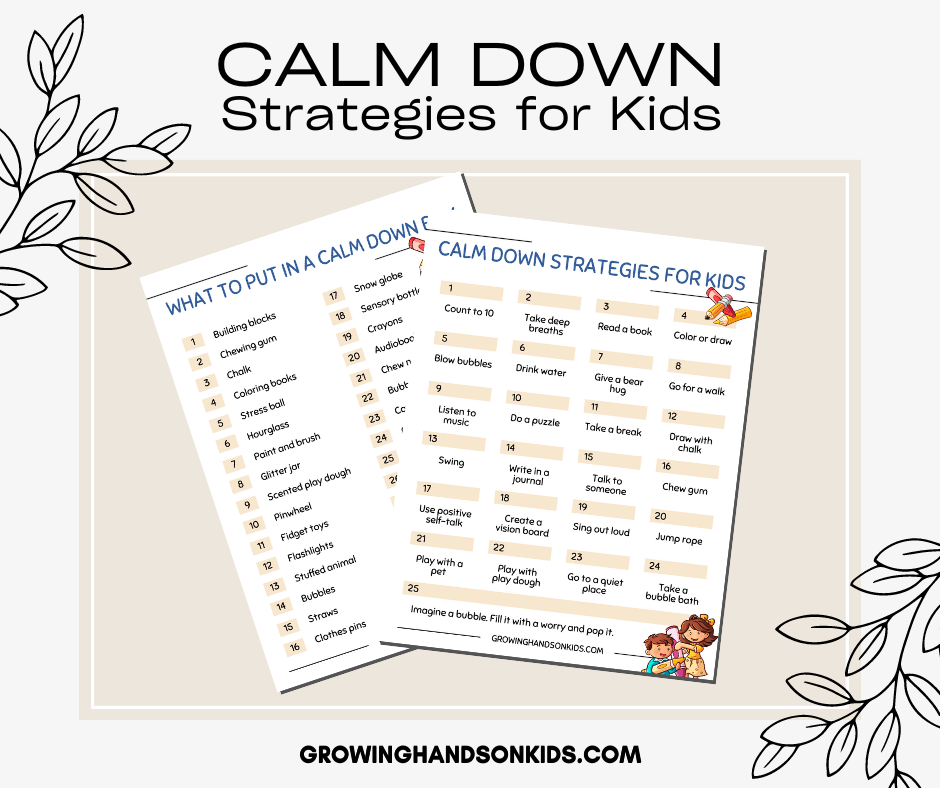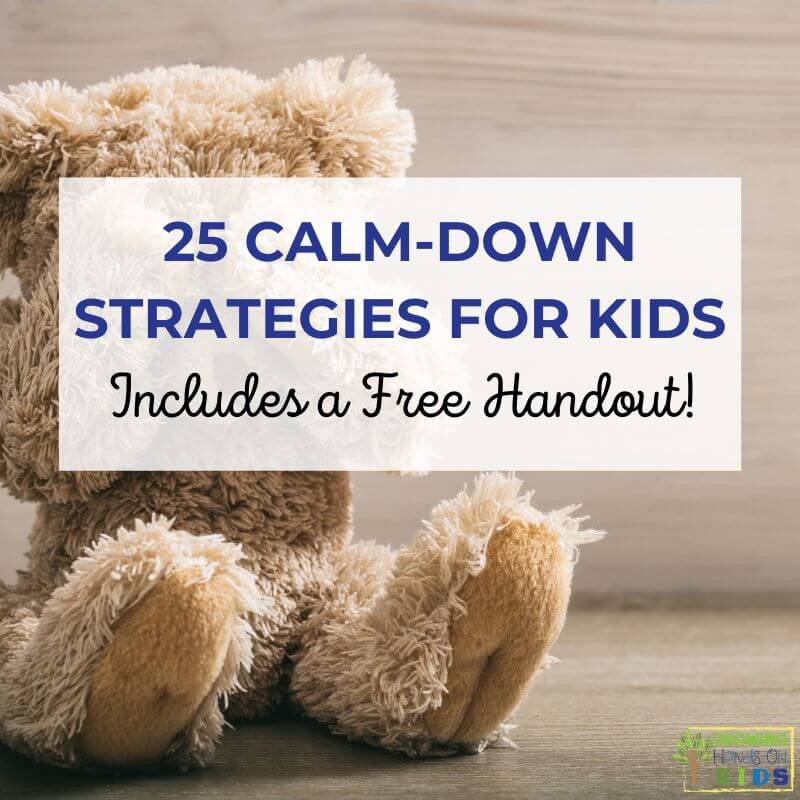32 Things To Put In A Calm-Down Box for Kids
Affiliate and Referral links are used below to promote products I love and recommend. I receive a commission on any purchases made through these links. Please see my disclosure policy for more details. As an Amazon Associate, I earn from qualifying purchases.
If your child becomes anxious or very upset, having a Calm Down Box can help your child feel more comfortable and self-regulate. Here are 32 ideas of what to include in a calm-down box for your child or student.
32 Things To Put In A Calm Down Kit for Kids
The items you can include in a calm-down kit are really endless. But here are 32 ideas to get you started.
- Building blocks
- Chewing gum
- Chalk
- Coloring books
- Stress ball
- Hourglass
- Paint and brush
- Glitter jar (here's a DIY idea for glitter jars)
- Scented playdough (here's a recipe for homemade playdough)
- Pinwheels
- Fidget toys
- Flashlights
- Stuffed animal
- Bubbles
- Straws
- Clothes pins
- Snow globe
- Sensory bottles (Here are some DIY ideas for sensory bottles)
- Crayons
- Audiobook
- Chew necklaces
- Bubble wrap
- Cotton balls
- Pom poms
- Skipping rope
- Puzzles
- Blank notebook
- Calm down jar (here is a DIY calm down jar idea)
- Photo album (can include pictures of family or some of their favorite items)
- Pillow
- Calming music
- Resistance bands
Some other ideas can include noise-canceling headphones, clay, hard candies, kinetic sand, slime, pipe cleaners, kaleidoscopes, silly putty, or markers.
What are some of your favorite tools to include in a calm-down box?
Benefits of Calm-Down Boxes or Kits
Calm-down boxes or kits have been found to be helpful for children to help reduce anxiety and stress. Many children on the Autism spectrum, or diagnosed with Anxiety, ADHD, or any child who struggles with emotional regulation skills.
Teaching children safe ways to regulate their emotions in different environments is where having a calm-down box can be helpful.
Having a calm down box or kit available for children at home, in the classroom, in the doctor's offices, and even in the hospital has been shown to be very helpful for many children by helping to decrease their anxiety and help them cope with stressful situations.
With the emergence of trauma-informed practices in the classroom, having a safe and peaceful space for students to work through their emotions and take a break in a positive way. Improving how children cope and react to their emotions has a positive outcome on their learning
For many children, doing activities that include proprioceptive input, or heavy work, can have a calming effect. Other activities that focus on oral-motor and supporting deep breathing and relaxing can also be extremely beneficial for many kids.
You can read more about proprioceptive input here.
Free Handout of What To Put In a Calm Down Box
Subscribe to Growing Hands-On Kids for my weekly newsletter and get a free printable of the Calm-Down Strategies and What to put in a calm down box handout as a free gift.
When you subscribe to my email list, you'll also be the first to know about new printables or products I create and products I recommend.
If you have already subscribed to GHOK, don't worry, you aren't actually subscribing again. Entering your email below just lets my email service provider know which printable download to send you. You will not receive duplicate emails from me in the future.
References:
Drake, Jennifer; Johnson, Norah L.; Stoneck, Alice V.; Martinez, Deb M.; and Massey, Megan, “Evaluation of a Coping Kit of Items to Support Children with Developmental Disorders in the Hospital Setting” (2012). College of Nursing Faculty Research and Publications. 155. https://epublications.marquette.edu/nursing_fac/155
Duginske, J. “Tier two social-emotional learning to increase academic achievement.” (2017) Concordia University Chicago.
Luze, G. “Supporting Children to Regulate Their Emotions with a Calm Down Kit” (2019). Iowa State University Early Childhood Education Information Brief. https://hdfs.hs.iastate.edu/
Nagy, A., Rude, C. “Calm spaces in schools: a resource guide” (2022). Hennepin. State Health Improvement Partnership. https://www.hennepin.us/
Thompson, C. “The Impact of a Classroom Calm Down Corner in a Primary Classroom”. (2021). Northwestern College, Iowa. https://nwcommons.nwciowa.edu/education_masters/
You May Also Like:

Heather Greutman, COTA
Heather Greutman is a Certified Occupational Therapy Assistant with experience in school-based OT services for preschool through high school. She uses her background to share child development tips, tools, and strategies for parents, educators, and therapists. She is the author of many ebooks including The Basics of Fine Motor Skills, and Basics of Pre-Writing Skills, and co-author of Sensory Processing Explained: A Handbook for Parents and Educators.



